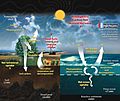Carbon sink facts for kids
A carbon sink is like a giant storage place for carbon. Imagine a big sponge that soaks up carbon from the air. These places, whether natural or man-made, hold onto carbon for a very long time. They are super important because they absorb more carbon than they let out.
Our planet has many natural carbon sinks. Forests, oceans, and even the soil beneath our feet all store carbon. This carbon is always moving around in a continuous cycle. Some of the biggest natural carbon sinks include swamps, bogs, and even ancient coal measures deep underground.
In the natural carbon cycle, carbon dioxide (CO2) from the air is taken in by plants. Plants use this CO2 to make their food through a process called photosynthesis. This helps remove carbon from the atmosphere.
Contents
What is a Carbon Sink?
A carbon sink is any system that absorbs more carbon than it releases. Think of it as a net absorber of carbon. This helps balance the amount of carbon in our atmosphere. Carbon is a key element found in all living things and in the air as carbon dioxide.
Why Carbon Sinks are Important
Carbon sinks play a vital role in keeping our planet healthy. They help control the amount of carbon dioxide in the atmosphere. Too much carbon dioxide can lead to climate change and a warmer planet. By storing carbon, these sinks help reduce the impact of human activities on the environment.
Types of Carbon Sinks
Carbon sinks can be natural or created by humans. Both types are important for managing carbon levels.
Natural Carbon Sinks
Nature provides many powerful carbon sinks. These include:
- Oceans: The world's oceans are the largest natural carbon sink. They absorb a huge amount of carbon dioxide from the atmosphere. This carbon dissolves in the water and is used by marine life.
- Forests: Trees and plants take in carbon dioxide during photosynthesis. They store this carbon in their wood, leaves, and roots. Old-growth forests, with their many large trees, can store vast amounts of carbon.
- Soil: Soil contains a lot of carbon from decaying plants and animals. Healthy soils can hold a significant amount of carbon.
- Peatlands and Wetlands: Places like swamps and bogs are rich in waterlogged soil. This environment slows down the decay of plants, allowing them to store carbon for thousands of years.
Man-Made Carbon Sinks
Humans are also trying to create or improve carbon sinks. These are often called carbon capture and storage (CCS) technologies.
- Carbon Capture and Storage: This involves capturing carbon dioxide from industrial sources, like power plants. The captured carbon is then stored deep underground in special rock formations.
- Afforestation and Reforestation: Planting new forests (afforestation) or replanting trees in areas where they were cut down (reforestation) are ways to create more carbon sinks. These new trees will absorb carbon as they grow.
- Bioenergy with Carbon Capture: This process grows plants for energy. The carbon released when the plants are burned is then captured and stored.
The Carbon Cycle Explained
The carbon cycle is the natural process where carbon moves between the atmosphere, oceans, land, and living things.
- Carbon dioxide is released into the atmosphere from breathing, decaying matter, and burning fossil fuels.
- Plants absorb carbon dioxide from the air for photosynthesis.
- Animals eat plants, taking in carbon.
- When plants and animals die, their carbon returns to the soil or oceans.
- Over millions of years, some carbon can form fossil fuels like coal and oil.
Carbon sinks help keep this cycle balanced. When humans release too much carbon, these sinks work harder to absorb it.
Images for kids
-
This diagram of the fast carbon cycle shows the movement of carbon between land, atmosphere, soil and oceans in billions of tons of carbon per year. Yellow numbers are natural fluxes, red are human contributions in billions of tons of carbon per year. White numbers indicate stored carbon.
See also
 In Spanish: Sumidero de carbono para niños
In Spanish: Sumidero de carbono para niños




